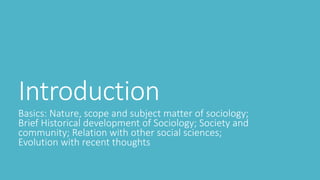
Sociology lecture 1.pptx
- 1. Introduction Basics: Nature, scope and subject matter of sociology; Brief Historical development of Sociology; Society and community; Relation with other social sciences; Evolution with recent thoughts
- 2. Introduction Definition: Sociology is the systematic study of the relationship between individuals and society. Sociology, a social science that studies human societies, their interactions, and the processes that preserve and change them. Humans depend on social institutions and organizations to inform their decision and actions. The family, community, peer groups, clubs and volunteer associations etc. Auguste Comte, a French social thinker, Known as Father of Sociology, as he coined the term ‘Sociology’ in 1839. Theoretical perspectives; Structure-Functionalism, Social-Conflict Perspective and Symbolic Interaction.
- 3. Sociological Perspectives 1- Structural-Functionalism: • Focuses on consensus and cooperative interaction in social life, emphasizing how the different parts of a society contribute to its overall operation. • The roots of work can be found on the work of Spencer and Durkheim. • Also known as Functionalism Or the functionalist paradigm. • According to this perspective; 1. a social system’s parts are interdependent, for example, family, court, school, the economy, that work together to produce social stability. 2. the system has a healthy state of equilibrium, analogous to a healthy body; 3. a change in one part of system results in change in another part to compensate. • Manifest functions; are obvious and intended. • Latent functions; unorganized and unintended. • Social dysfunctions; undesirable.
- 4. 2. Social- Conflict perspective • Conflict theories focuses on issues of contention, power, and inequality, highlighting the competition of scarce resources. • groups are competing for unequally distributed resources. • The works of Karl Marx credited for providing social- conflict perspective. • Randall Collin points out, much of the history of the world is a history of conflict.
- 5. 3. Symbolic Interaction: • Focuses on how society emerges from people’s se of shared symbols in the course of their everyday interactions. • Highlighting that the social world is based on interaction between people using cultural symbols, such as words and gestures. • It forms the basis of social structure. • Symbolic interactionism is based partly on the writings of German sociologist Max Weber.
- 6. Nature and Scope Nature: Sociology studies the social rules, and the role that humans play by living these rules. Why human beings bind by these rules. How does human social life impact their behavior in general is studied by sociology. There are criminals, convicts, rapists, and murders. However, somewhere society has played an important and distinguishing role to have caused such psychological behaviors in people. Human beings are sensitive creatures because we can express and feel emotions. These emotions can play havoc with the human psyche if misused or misunderstood. One has to understand the repercussions of it in a social environment and act responsibly.
- 7. Scope: Development activities Social Mobilization Rural Development Population Planning Rural Health Schemes Community Development
- 8. Brief historical development of sociology sociology separated from moral philosophy to become a specialized discipline. August Comte coined the term ‘sociology’ in 1839. The idea of applying the scientific method to the social world, known as positivism, was apparently proposed by August Comte. He became interested in two interrelated issues; social order (social static) and social change ( social dynamics). Karl Marx is best known for his work on capitalism and the role of conflicts in society. Capitalism is the mode of production based on private ownership of the means of production. Emile Durkheim, French Sociologist focused on social solidarity. Durkheim pointed out that groups can be held together on two contrasting bases: mechanical solidarity, a sentimental attraction of social units or groups that perform the same or similar functions, such as preindustrial self-sufficient farmers; or organic solidarity, an interdependence based on differentiated functions and specialization as seen in a factory, the military, government, or other complex organizations.
- 9. Society and Community Society: A society consists of people who interact and share common culture. Society includes social institutions i.e., The family, community, medical system, military system, political system, economic system, educational system, peer groups, clubs and volunteer associations etc. what happens in economy, for example, impacts all other institutions to some extent. Community: First, a community is a group of people who interact with one another, for example, as friends or neighbors. Second, this interaction is typically viewed as occurring within a bounded geographic territory, such as a neighborhood or city. Third, the community’s members often share common values, beliefs, or behaviors
- 10. Relation with other social Sciences Anthropology Political science Economics History Psychology